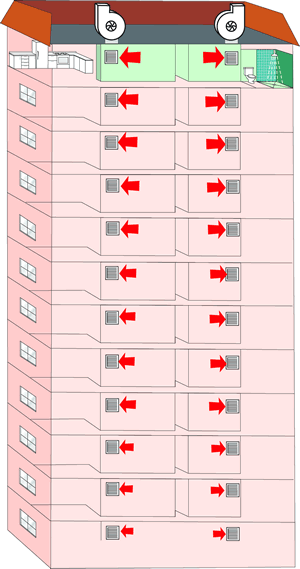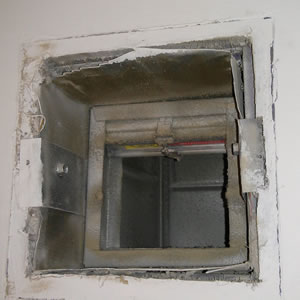When benchmarking more than 400 buildings for New York City’s Local Law 84 this year, we found that median energy consumption for buildings taller than 20 stories was 87 kBtu per square foot. The minimum and maximum ranges were between 50 and 258 kBtu per square foot.
What causes such a big difference in energy consumption from building to building, and what are the best measures to implement in order to keep tenants happy and get the most ROI?

The bigger the arrows in this diagram, the larger the flow. This diagram illustrates how, in a typical unbalanced kitchen and bathroom exhaust in a multi-family high-rise, airflow is greater in apartments closest to fans. Courtesy of American ALDES Ventilation Corp.
From Paper to Practice
Lots of things change from the time a building is conceived and put down on paper to when it is actually built. Functional items are value engineered out for aesthetic appeal (a comfortable, easy HVAC system is replaced with granite countertops, track lighting, and stainless steel appliances, for example). These are features tenants can see, so they’re often what drive market prices. But when this happens, facilities managers and engineers frequently hear questions from tenants like: “Why do I smell my neighbors’ cooking and smoking?” “Why do I have a small waterfall in my apartment in heavy rains?” “Why do the doors and windows howl, and why are they often hard to open or close in the wintertime?” The answers are related to ventilation systems and air sealing – systems that might sometimes be skimped on in order to provide tenants with more visually appealing features.
Buildings Need to Breathe
Typical high-rise buildings have central exhaust fans that serve multiple spaces. The fans are often located on the roof or in the basement, and exhaust a vertical shaft that extends the height of the building with connections to apartments at each floor. As air moves through a duct, it rubs against the side and creates friction. Exhaust ducts aren’t always sealed well and can be very leaky. This resistance and loss of pressure is greatest at the farthest point from the fan because that air has the longest distance to travel. Code officials knew this, which is why the pre-2008 building code required more than twice the amount of ventilation mandated today.
Per the code, apartment buildings aren’t required to match the exhaust ventilation rates. Most high-rise buildings exhaust twice the amount of air they are supplying, resulting in extreme negative pressure (think of how sucking the air out of an empty juice box causes it to implode). The building is starved for make-up air, which makes it hard to open or close windows and doors. It also sucks in unconditioned air and water. While all exterior doors, windows, and joints in the building envelope have leakage, some buildings have much more than others.
We’ve seen a 40-story building appear to defy the laws of physics by sucking air in during one of the coldest winters New York City experienced in over 20 years. Because warm air rises, you would expect to see vents gushing air out at the top of the building; however, the extreme negative pressure of the ventilation system overpowers the stack effect phenomena.

Large gaps in the duct-to-drywall connection, as shown here, will result in wasted energy and indoor air quality problems. Courtesy of Greenwich Energy Solutions
Conventional systems inherently waste at least $2,000 in energy costs per line of apartments in a 20-story high-rise. New buildings that follow the new lowered ventilation rates but don’t adhere to quality duct sealing won’t be able to provide enough exhaust at the end of the duct. As a result, they face severe IAQ problems (and will likely face questions and complaints from tenants about odors and howling noises).
Practical Solutions
There are new products on the market that vastly improve existing systems without tearing open walls to get at ductwork. One example is non-toxic, aerosolized glue that is blown into ducts, accumulates at a leak, and seals it. Another technology uses a robotic arm dropped down into the shaft with a camera and nozzle to paint the sealant on. Non-electric, automatic balancing devices are also available to bypass very costly and near-impossible TAB services.
In new construction, these products and technologies are simple and cost effective. This is a no-brainer slam dunk with serious ROI in the form of fewer callbacks and lawsuits. This also means significant reductions in operating costs if the developer manages the building once occupied. Existing buildings present a bigger challenge with apartment access issues, but portions of the duct can be isolated to make it feasible. Furthermore, there are often many exhaust ducts located in common areas that can be accessed easier and still contribute to significant overall savings and increased comfort.
People used to think that buildings needed to breathe freely. With rises in energy costs and years of complaints, however, a new mantra has emerged: built tight and ventilate right. We need to do a better job of following through and holding developers and contractors accountable for installing systems that actually work in the real world – and not just on paper.
Test, Adjust, Balance … Repeat
Dampers on registers or grilles can typically be adjusted through levers or adjustment knobs hidden inside. Building staff are usually the only ones who know where to look for the hidden knobs (and have the right screwdriver to adjust them). The dampers balance the system and provide each tenant with the same airflow. Apartments farthest from the fan can have dampers completely open. The closer an apartment is to the fan, the more the dampers should be closed.
High-rise duct specifications always include a testing, adjusting, and balancing (TAB) requirement. Manually balancing a large ventilation system is difficult to do correctly. Adjustments made to the airflow on just one register have a domino effect. Exhaust systems are also sensitive to wind and pressure variation outside, so the system is only balanced correctly until the weather changes. With that in mind, it seems necessary to have a system that can respond automatically to variations in the environment.
Keirnyn Ross
Keirnyn Ross, CEM, is manager of energy engineering at Greenwich Energy Solutions.

